Melissa Potter and Maggie Puckett work in a terrain that cultivates socially conscious art in an environmental and eco-feminist dialogue. The COMP Magazine recently visited these artists at the Center for Book & Paper Arts for a discussion on using organic materials to create handmade paper, seed saving, contributing to an urban community, and properly aligning print rollers.
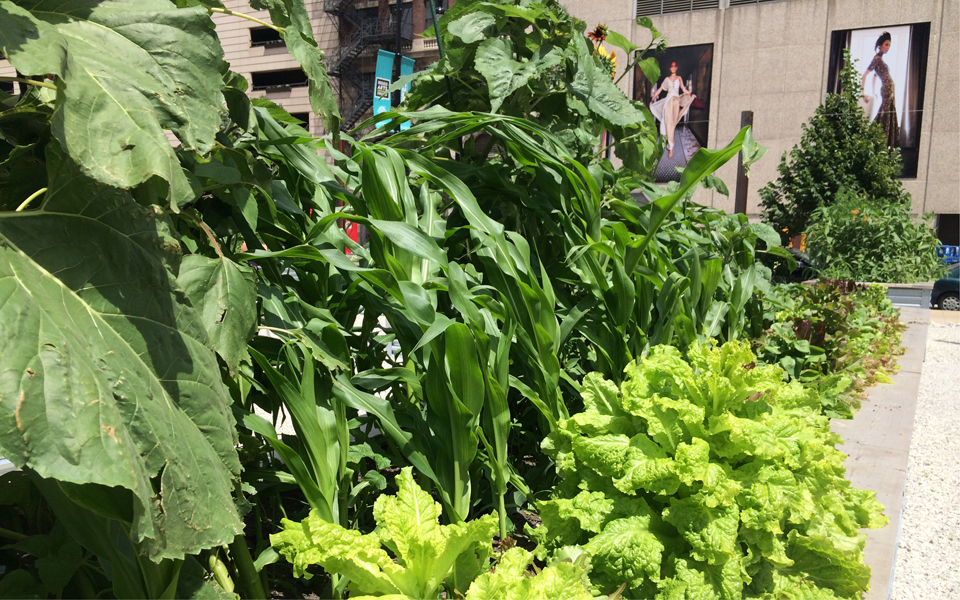
Melissa Potter and Maggie Puckett, Seeds InService Garden, 2014
Well, the two of you are from opposite coasts and stumbled upon each other here in Chicago. Can you tell us about your backgrounds, relocation to the windy city, and how your partnership developed?
I met Maggie when she entered the MFA Book & Paper Program in the Interdisciplinary Arts Department at Columbia College Chicago back in the fall of 2008. It was my first year as an Assistant Professor after relocating from New York, and we bonded pretty immediately over our shared interests in political art. Maggie had training and practice as an artist and graphic designer at NYU where she did her undergraduate degree, but not hand papermaking. Once she got started, she didn’t really stop. Her thesis project revolved around her experiments with the medium and its relationship to the environment.
I curated a show at The Center for Book & Paper Arts in 2009 called Among Tender Roots, featuring the work of Laura Anderson Barbata. One of her projects is with the Yanomami people of the Venezuelan rainforest. Her collaborators were so excited about their work being featured in the exhibition that the Venezuelan consulate and the IDEA Foundation paid for Yanomami community leader, Sheroanawë Hakihiiwë and Alvaro Gonzalez Bastides to travel to Chicago. It was one of a handful of times a Yanomami community member had been out of Venezuela! Maggie helped with the first limited edition of works by Hakihiiwë inspired by his Yanomami heritage that we created in the Center’s papermaking studio.
The project was so successful that the following year, we were invited to Caracas with another Book & Paper alumna, Haley Nagy to collaborate on the production of an artist’s book inspired by Yanomami creation stories. We worked together all day, every day beating hard fibers for the books. I would say that cemented my collaboration with Maggie! Over time, we did more and more together, and on a drive to visit a friend’s exhibition, we came up with the Seeds InService project. Maggie taught me everything I know about gardening, since I started with practically no ability at all. Now in its second year, we plan to do more intensive training on seed saving, deepen our relationships with partnering organizations, and make more art based on our gardening and research.
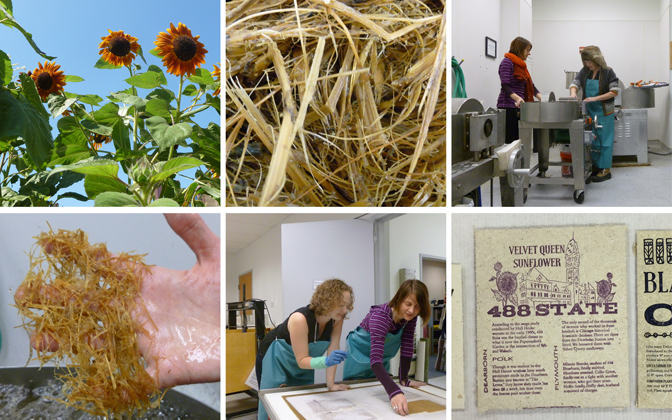
Melissa Potter and Maggie Puckett, Sunflower Paper, 2014
The term eco-feminist was tossed around during the portrait session. Often, the term feminist can be broad and misleading. What exactly is an eco-feminist? Does each of you see this identification appropriate?
The term écologie-féminisme was introduced in Paris 1972 by Francoise d’Eaubonne at her eco-feminist center where she challenged women to lead an ecological revolution. Why women? Capitalism (patriarchy’s most recent manifestation of control over the production and reproduction of life ) necessarily exploits both nature and women as resources for capital accumulation. Carolyn Merchant wrote, “Ecofeminist actions address the contradiction between production and reproduction. Women attempt to reverse the assaults of production on both biological and social reproduction by making problems visible and proposing solutions.” In Seeds InService, Potter and I attempt to make visible the problems of the global food system and industrial farming: monocultures requiring massive pesticide use, greenhouse gas emissions, soil degradation, pollution, habitat destruction, as well as the global division of labor that allows the powerful post-industrialized countries of the northern hemisphere to exploit cheap labor (mostly women) in countries in the southern hemisphere (often former colonies). Through eco-feminism, women challenge the way mainstream society reproduces itself both intra- and inter-generationally.
In her book Radical Ecology, Merchant describes how in colonial and capitalist societies, “women’s direct interactions with nature have been circumscribed. Their traditional roles as producers of food and clothing, as gardeners and poultry tenders, as healers and midwives, were largely appropriated by men.” Furthermore, once appropriated, the modes of production were reassessed under burgeoning early merchant capitalism, making them more exploitative of nature, now seen as a resource, no longer the nurturing mother. It is up to women to reclaim, re-envision modes of production and reproduction that are not exploitative of women, nature, and colonies.
According to Australian sociologist Ariel Salleh, “Ecofeminism is the only political framework I know of that can spell out the historical links between neoliberal capital, militarism, corporate science, worker alienation, domestic violence, reproductive technologies, sex tourism, child molestation, neocolonialism, Islamophobia, extractivism, nuclear weapons, industrial toxics, land and water grabs, deforestation, genetic engineering, climate change and the myth of modern progress.”
Controversial eco-feminist Dr. Vandana Shiva ushered in 2015, the UN’s International Year of Soil, with a powerful message: “We are all Seeds, that for a while we might lie underground, but at the right moment we germinate and burst out with all our potential.” SIS is part of this grassroots movement that’s beginning to germinate, preparing to burst forth. Jane Addams, a Nobel Prize winner, and underrepresented American historical figure who founded The Hull House in 1889, combined social engagement with feminism, inspiring projects like SIS to continue her vision working toward social change. “In the soil and the seed we find answers to every one of the crises we face” Vandana Shiva said. “The crisis of violence and war, the crisis of hunger and disease, the crisis of the destruction of democracy.”
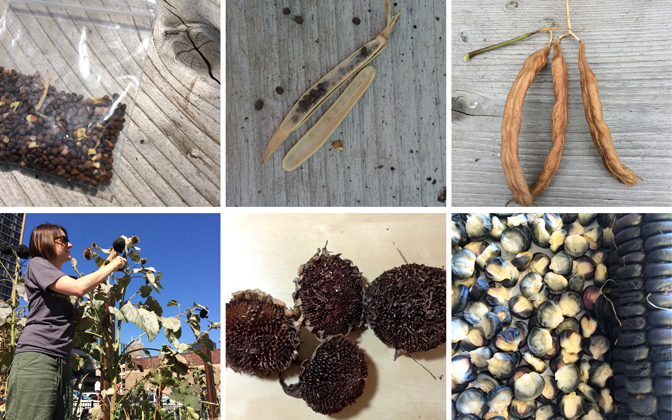
Melissa Potter and Maggie Puckett, Seed Saving, 2014
Can you share your artistic process? You essentially work from garden to printing press in relatively short proximity? Is the fact that you are working in an urban environment of any signficance?
Because we grow our own materials, we like to laugh about our process as “slow art”. But in all seriousness, our process joins the current Slow movements in their desire to return to a rhythm more syncopated to nature. No fast food and no fast art. This gives the chef and the artist time to consider the source of their materials and their impact on the world around them. We begin by carefully considering the species we will plant in our raised beds. Space is limited and the stakes are high, the crop needs to sustain our artistic projects through the year. Because we want to champion biological diversity and indigenous species, we select heirloom and local varieties of plants that provide high-quality cellulose fiber for papermaking. This year we will be focusing on corn of pre-colonial America (Seneca Red Stalker, Oaxacan Green Dent, Black Aztec, Bloody Butcher) and midwestern prairie flowers and grasses. Chicago’s winter feels neverending so we generally plant our seeds in May when the nights are warm enough not to kill the baby plants. Summer heats up quickly and we find ourselves loving all the awesome rainstorms common in Chicago’s hot months. Over the summer we tend the plants, water them, collect seeds from flowering plants, host papermaking and seed bomb workshops. In the fall we harvest our plants, dry them, and begin processing them into pulp. This year we made seed packets and posters with the pulp we made from our harvest. This included letterpress printing our designs onto the handmade paper. Printing aficionados will appreciate the difficulty of printing on non-rectilinear handmade paper sheets of varying thicknesses!
Our urban location is absolutely of significance to the project. Not only logistically as space is limited, rain is acidic due to pollution, sunlight is blocked by high-rises, but also because urban dwellers are the most alienated from the modes of food and fiber production. Half a million Chicagoans live in a food desert, more than one mile away from a grocer with fresh produce. Of that produce, only six percent is grown in Illinois. Potter and I buy shares of edible harvests from local farms in Community Supported Agriculture programs, by growing fibers and we extend this practice to our art.
Many papermakers buy their fibers pre-processed, leaving them in the dark about how and where the fiber was grown, what pesticides were used, how much (little) the workers were paid, the distance it traveled to reach the studio. Most artists in general can’t answer these questions when it comes to their materials. It’s really hard, slow work, but we can answer those questions with pride when it comes to our hand-grown fibers.
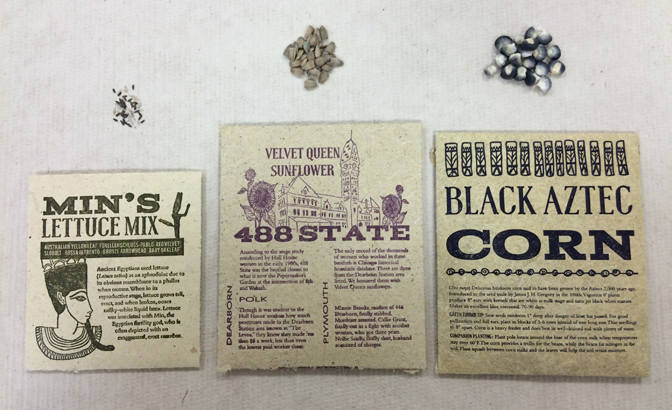
Melissa Potter and Maggie Puckett, Seed Packets, 2014
In your current collaboration you are producing a series of work for the Hull House Seed Library. Can you offer a summary of the seed library and your goal in contributing to building its’ holdings?
Following the traditions of its founders, The Jane Addams Hull House Museum has a robust program fostering all different kinds of creative community engagement. One of their programs is called ReThinking Soup!. The program offers soup to participants brought together to discuss and workshop important social, political, and artistic ideas, just as Jane Addams did with her radical dinner parties. We saw their seed library as an extension of these ideas, and recognized it as an incredible opportunity to metaphorically grow the ideas and passions of Jane Addams and her legacy in our garden. The Seeds InService project uses the inedible material from the plants for paper, and harvests the seeds for redistribution to interested community members, as well as the Hull House Seed Library. It is currently a modest library, and our hope is to partner with them on seed saving workshops, and build our community networks so we can make a substantial contribution back to the library every year.
Activated through the transformative processes of hand papermaking we connect gardens initiatives to seed stewardship through art. Seeds InService provides the initial tools and education, disseminating knowledge and heirloom and local seeds to communities in need of fresh, local plant-based food. In the words of historian Jennie Sorkin: “The duo held harvesting and papermaking workshops and created an ad-hoc distribution center for radical feminist literature, which they distributed with the seeds and care instructions, extending the garden’s metaphor to mean the seeding or cultivation of future generations of activist artists and gardeners.”
Seeds InService is dedicated to educating the public on the joys of seed stewardship through artistic and workshop interventions. By growing, saving, and distributing local and heirloom varieties to urban farms and community gardens, we address the problem of biodiversity loss. By arming urban communities with the regenerative seed, we offer them a piece of control over their increasingly threatened food supply. By engaging them in the art of hand papermaking as well as gardening, we reinforce their interconnectedness to the rhythms of nature, from which we all come and go. Making paper from plant material that you’ve grown creates a living interconnectedness.
Radical Craft is a term we use to describe our garden-to-studio-to-community art practice. It embraces the ethics of Jane Addams. At Hull House, diverse communities shared their cooking and craft arts, fostering religious and social tolerance and strengthening local economies. Addams also believed crafts heal: through the fruits of the labor and beauty we produce with our hands, we are restored from the hardships of overwork and systematized labor. Radical Craft is a declaration that so-called “women’s work” is of value, that women’s knowledge is of value.
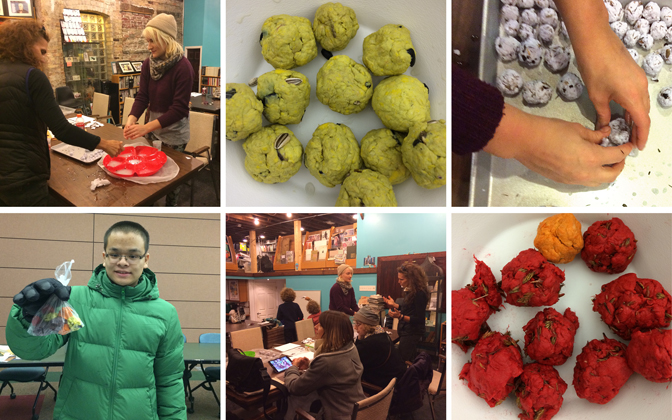
Melissa Potter and Maggie Puckett, Seed Bomb Workshop, 2014
You both appear to be natural educators. Your passion for your current work was easily felt. Do you see teaching as being integral in your present dialogue as artists?
Absolutely. The project engages current theory in social practice, especially the work of Pablo Helguera, who believes creative education is an artistic act. Grant Kester, Stuart Keeler, and Claire Bishop also challenge and shape an expansive concept of artistic practice as interdisciplinary in nature, and often in collaboration with students, and a community. Their philosophies defy the status quo concepts of artist as producer of objects for sale. Very often, Jane Addams and John Dewey are mentioned as major influencers in this idea of social practice. Art existed in many different acts, all of them towards the common goal of a healthy, creative, and fulfilled life for all people of all different classes and walks of life.
The project focuses on interactive programs and artworks that are activated and become relevant through distribution. Seeds InService very specifically embraces Claire Bishop’s concept of the “mediating third term:” an object, image, perhaps a spectacle that translates an idea into something shared and tangible.
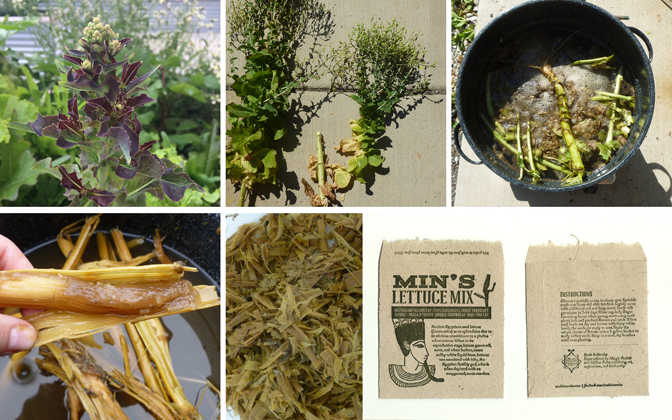
Melissa Potter and Maggie Puckett, Lettuce Paper, 2014
So, what are you planting this spring in the Wabash Garden? Are there any new projects set for the New Year?
We are hoping since we had such a fruitful season in 2014 that The Papermaker’s Garden at Columbia College Chicago will offer Seeds InService two beds this year! This will allow us to continue with food based fibers, as well as indigenous prairie grasses which are superb for hand papermaking and provide wonderful links to the prairie preservation movement in the Midwest. It also will give us space to do special collaborations, like our work with University of Wisconsin potato farmer, Doug Rouse. We grew some of his potatoes to see if we could make paper from the stalks. This could be a very interesting option for farmers, since there is so much unusable plant material in the harvest.
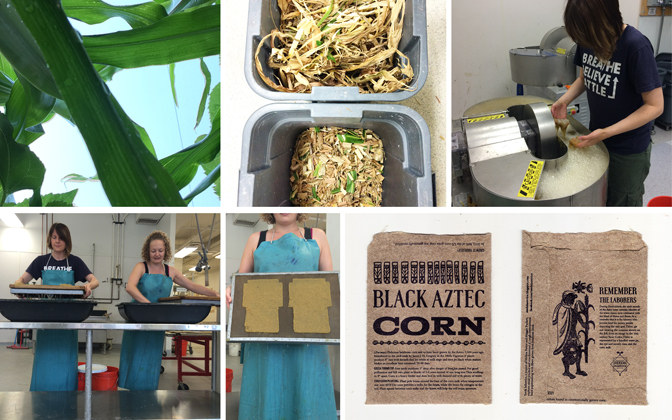
Melissa Potter and Maggie Puckett, Black Aztec Corn Paper, 2014
For additional information and ongoing updates on the work of Melissa Potter and Maggie Puckett’s Seeds InService project, please visit: www.seedsinservice.com
References:
1. Merchant, Carolyn. Radical Ecology: The Search for a Livable World. New York: Routledge, 1992. Print.
2. Mies, Maria, and Vandana Shiva. Ecofeminism. London: Zed, 2014. Print.
3. Ibid.
4. Mies, Maria, and Vandana Shiva. Ecofeminism. London: Zed, 2014. Print.
5. “We Are All Seeds – A New Year Message from Dr. Vandana Shiva for 2015.” Seed Freedom RSS. 28 Dec. 2014. Web. 05 Jan. 2015.
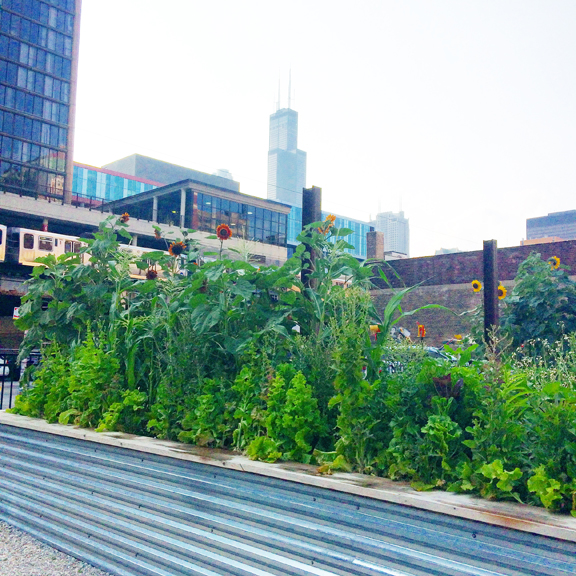
Melissa Potter and Maggie Puckett, Seeds InService Garden, 2014
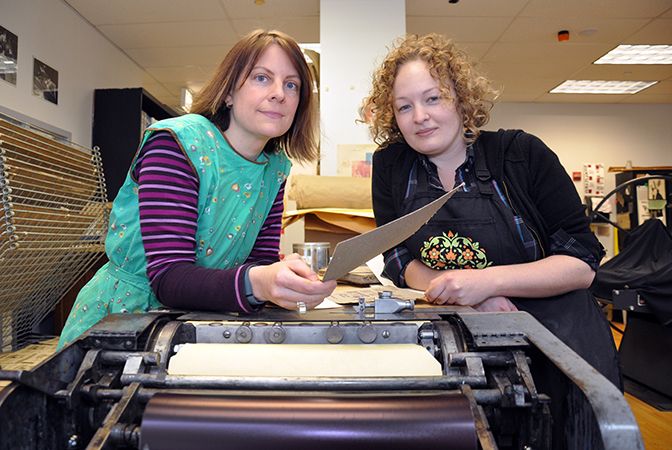
Melissa Potter and Maggie Puckett, printmakers, Chicago, 2015
Interview and portrait by Chester Alamo-Costello


